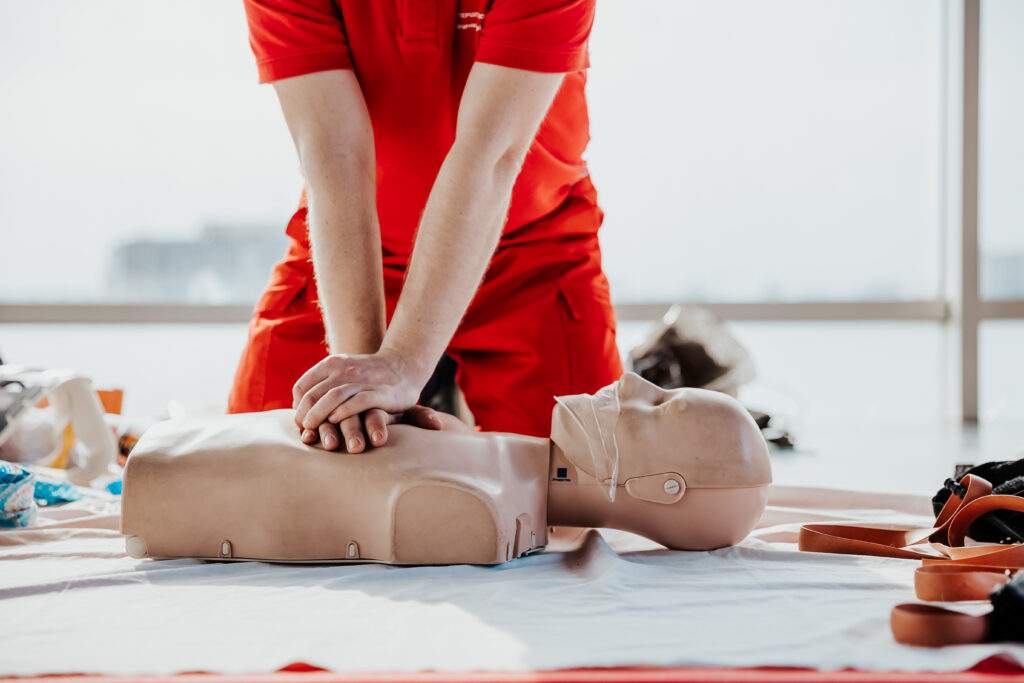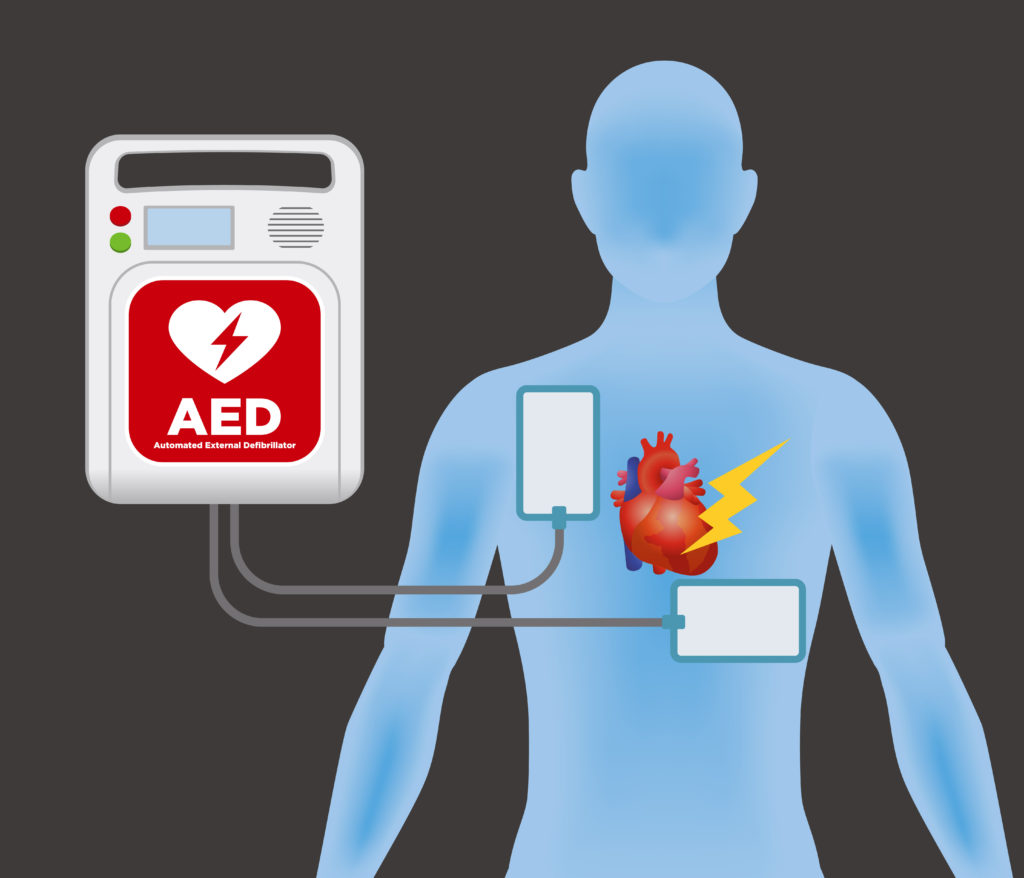
Get CPR training for your team!
If you have any questions feel free to email us at info@emccprtraining.com
CONTACT ONE OF OUR EXPERTS HERE

Last Updated on January 28, 2024 by CPR Training
Implementing CPR training can feel like a daunting task. Indeed, when it’s time to prioritize safety in the workplace, their #1 concern is… implementing CPR and AED Training.
Many are left in the dark as to how to begin. But this is what separates an average employer from a safety-conscious business owner. If you’re unsure how to introduce effective CPR and AED programs sustainably, you might never reach this level of preparedness.
CPR and AED training are vital in your organization’s health & safety toolkit. These skills can be lifesavers during emergencies like sudden cardiac arrest.
The advantage of having these competencies within your team is twofold: not only does it empower individuals to act swiftly and effectively when lives hang in the balance, but it also contributes significantly towards fostering a culture of care and preparedness at work.
CPR (Cardiopulmonary Resuscitation) involves giving chest compressions along with rescue breaths that help maintain blood flow to essential organs when someone’s heart has stopped beating. It’s an emergency procedure performed until healthcare providers arrive on the scene.
An Automated External Defibrillator (AED), on the other hand, delivers a shock aimed at restarting the heart during cardiac arrest scenarios. This device provides clear instructions, allowing even untrained personnel to save lives under critical circumstances potentially. The American Heart Association recommends widespread use of AED devices as they increase survival rates dramatically if used promptly after the onset of symptoms.
Meanwhile, first aid skills enable an immediate response to injuries or illnesses before professional medical assistance arrives.

Beyond individual benefits, equipping employees with the knowledge and capabilities to perform CPR and use an AED fosters overall workplace safety by ensuring there’s always someone capable of responding quickly should disaster strike. Furthermore, this demonstrates a commitment towards staff and customer wellbeing, which enhances corporate reputation while building trust among family members and their loved ones in a safer environment.
Additionally, proactive measures such as implementing CPR and AED training onsite at your location often result in cost savings through reduced insurance premiums due to lower risk of accidents leading to severe injury or death, thanks to a comprehensive program in place.
Last but not least, a beneficial aspect of investing in training lies in its convenience and efficiency: since it takes place right where it is needed most – on the premises – it eliminates the need for offsite travel, thereby saving time and money for the company (source).
This practical approach allows them to begin immediately recognizing signs without wasting precious minutes waiting for paramedics or doctors to arrive, as every second counts.
In essence, organizations stand to gain tremendously by implementing a CPR and AED training program. Not only does this safeguard valuable personnel, but it also has a positive effect on the long-term financials.
Important Takeaway:
CPR, AED, and First Aid training are more than just emergency skills; they’re a crucial part of any organization’s safety toolkit. They foster a culture of care, boost corporate reputation, save time and money by reducing offsite travel for training, and even lead to lower insurance premiums due to decreased accident risks. In short, it’s an investment that pays off in both human lives saved and positive bottom-line impact.
Navigating the world of implementing CPR and AED training can seem overwhelming, with so many options. But fear not. To make the navigation easier, AHA, ARC, and HSI are here to provide guidance.
We’ll delve into each organization’s programs designed for your specific needs.
The American Heart Association’s CPR & ECC program is a global leader in providing healthcare providers with comprehensive knowledge on performing CPR and using an automated external defibrillator during cardiac arrest situations, such as starting chest compressions or giving rescue breaths. It’s like having a paramedic right at your fingertips.
This course also emphasizes hands-only CPR for bystanders who witness sudden cardiac arrests – call 911, then push hard and fast in the center of their chests until help arrives. Simple but lifesaving steps indeed.
The ARC has its unique approach to the First Aid/CPR/AED Program that equips individuals with skills needed when they experience health emergencies beyond heart-related crises. From recognizing signs of cardiac arrest to beginning immediate life-saving measures till professional medical aid arrives – this course covers it all. And yes, mouth-to-mouth rescue breath instruction is included for those critical scenarios where victims cannot breathe independently.
Catering to healthcare professionals and non-medical personnel, including family members potentially needing these vital skills amidst unexpected home/workplace emergencies.
Their courses cover cardiopulmonary resuscitation techniques plus first aid essentials, making them ideal choices across audience groups.
This institute combines online learning modules with practical skill evaluation sessions conducted by certified instructors, ensuring participants get a thorough understanding and hands-on experience before they face real-life situations confidently.
So whether you’re looking towards equipping staff with essential life-saving skills or seeking individual certification, there’s something suitable available from each of these esteemed institutions. So explore further, compare offerings based upon specific requirements, and make informed decisions because every second counts when lives are at stake.
Important Takeaway:
Don’t be overwhelmed by CPR/AED/First Aid training options. The AHA, ARC, and HSI offer tailored programs for diverse needs. From hands-only CPR to full-scale emergency response techniques, these courses equip you with life-saving skills – because every second counts.
Deciding on an AED can be challenging, but researching the features and benefits of major brands can make it easier to choose one that meets your organization’s health & safety needs.
We’re here to guide you through some of the major brands in the market today, highlighting their key attributes and how they could fit into your organization’s health & safety strategy.

The Philips HeartStart stands out due to its user-friendly design that makes performing CPR a more straightforward procedure for anyone. It provides clear voice instructions guiding users from starting CPR to using the defibrillator.
This device also has self-check capabilities, ensuring it’s always ready when needed. Its Quick Shock feature minimizes delays between chest compressions and shock delivery – a critical factor during cardiac arrest emergencies where every second counts.
Moving onto ZOLL’s AED Plus, what sets it apart is its Real CPR Help technology, providing real-time feedback on depth and rate of chest compressions while giving rescue breaths or hands-only CPR under stress situations.
This model boasts superior battery life compared with many competitors, which means fewer maintenance needs while guaranteeing readiness at all times – crucial for any emergency lifesaving procedure performed in workplaces or public spaces.
Powerheart G5 from Cardiac Science, another industry leader, offers dual-language capability, making it suitable for diverse environments. The automated adjustment shock delivery based on individual patient needs simplifies usage for family members and bystanders who might not be experienced healthcare providers.
In addition, robustness is a key consideration; dust-protected, water-resistant construction ensures durability even in challenging conditions.
As you explore these other notable options like Physio-Control LIFEPAK CR Plus and Defibtech Lifeline VIEW, remember that the selection involves much more than just comparing prices. Consider the specific environment and potential users’ familiarity with medical equipment, as well as additional support offered by manufacturers, such as training materials and customer service responsiveness.
Remember that having an accessible and easy-to-use automated external defibrillator can make the difference between life and death for someone experiencing sudden cardiac arrest. Thinking through the different possibilities today will enable you to choose a selection that meets your establishment’s safety objectives.
Important Takeaway:
Choosing the right AED brand is vital for workplace safety. Consider user-friendliness, self-check capabilities, real-time CPR feedback, battery life, dual-language capability, and durability. Remember: an accessible AED can be a lifesaver during cardiac emergencies.
If you’re in the market for an Automated External Defibrillator (AED), our sales services at EMC offer competitive prices and reliable customer service that can’t be beaten.
When investing in lifesaving equipment like an AED, we understand cost is a significant consideration. That’s why we’ve committed ourselves to offering top-tier devices without breaking your budget.
We provide access to all leading brands at affordable rates, ensuring safety within your organization and value for money are prioritized equally.
Selecting the right brand when purchasing an AED is critical. With us, you’ll find every FDA-approved manufacturer available on the market – each with unique features designed specifically for different environments or user skill levels.
No matter what specific requirements you have, rest assured knowing our team will guide you towards choosing the best fit from renowned manufacturers such as Philips or ZOLL Medical Corporation, among others.
In addition, high-quality products competitively priced also pride ourselves on providing unparalleled level support throughout the purchase journey beyond. Our experienced staff is always ready to assist in answering any questions or concerns about product selection operation instructions and AED legal compliance.
This commitment extends even after the sale; whether maintenance tips or troubleshooting advice is needed down the line, experts are just one call away.
We not only want to ensure that we make an informed decision but also feel confident and comfortable using a new device should the need arise.
Our bulk order options make it easier for organizations, big and small alike, to equip themselves with necessary life-saving devices affordably.
The process begins with discussing quantity desired budget constraints to help identify optimal solutions both financially and logistically speaking. Once an agreement is reached, orders are dispatched promptly and efficiently, ensuring timely delivery regardless of the size and scope involved.
With these considerations in mind, we invite you to explore various offerings. Feel free to reach out should you require additional information or guidance along the way. Remember, the goal here is not simply to sell but to partner clients, empowering them to create safer spaces for employees and customers thanks to the proper implementation of emergency medical equipment, including automated external defibrillators and CPR training resources.
Trust expertise experience comes with peace, knowing made a sound investment in health safety those care most about care about.
Important Takeaway:
Bag a bargain on lifesaving AEDs without skimping on quality or service. With EMC, you’ll get access to top-tier brands at competitive prices and stellar customer support that sticks around post-purchase. Plus, bulk buying options mean significant savings for larger organizations.
CPR requires a face mask or shield, gloves for protection, and potentially an Automated External Defibrillator (AED) if available.
CPR can double survival rates, it’s vital in cardiac arrests, and brain function declines after 4 minutes without oxygen. Anyone can learn it, and early intervention is key.
Besides the above five, chest compressions should be at least two inches deep; rescue breaths should last one second; AED use increases survival rates; hands-only CPR is effective; and untrained individuals should still attempt compression-only CPR.
The three C’s of CPR refer to Check (the scene and victim), Call (for help or emergency services), and Care (performing life-saving actions).
Implementing CPR and AED training isn’t just a safety measure; it’s an investment in your team.
You’ve learned the value of onsite CPR and AED training and how it can protect lives.
AHA, ARC, HSI – these aren’t just acronyms but lifelines for your workplace.
And remember those major AED brands? They’re more than machines; they’re potential lifesavers sitting on your office wall.
The road to program management might seem winding, but with expert advice, you’ll navigate like a pro.
Sales services are not merely transactions; they are steps toward building a safer workspace.
Check out our other blogs at https://www.emccprtraining.com/blog/.
Contact us at www.emccprtraining.com/contact or 800-695-5655 to learn about our onsite CPR/AED training and AED sales.
Get CPR training for your team!
If you have any questions feel free to email us at info@emccprtraining.com
CONTACT ONE OF OUR EXPERTS HERE